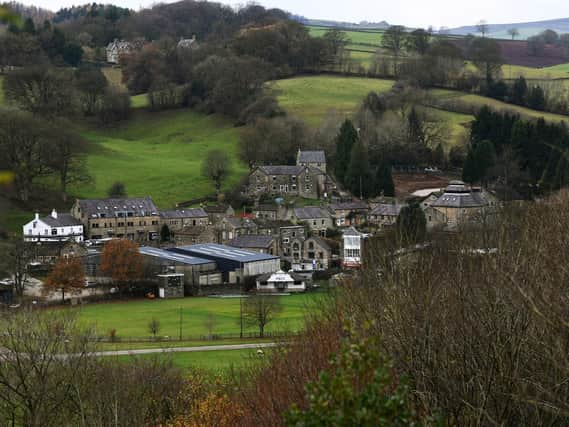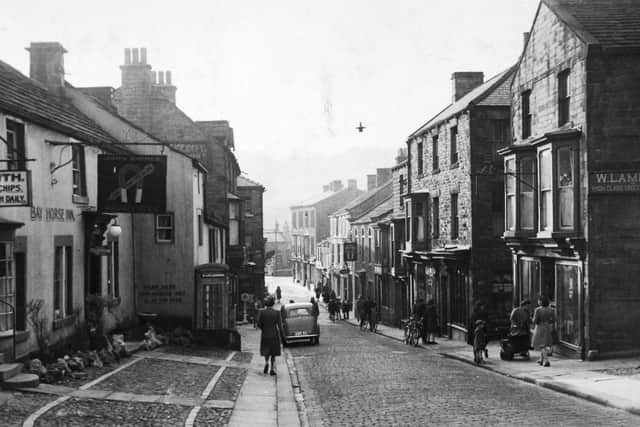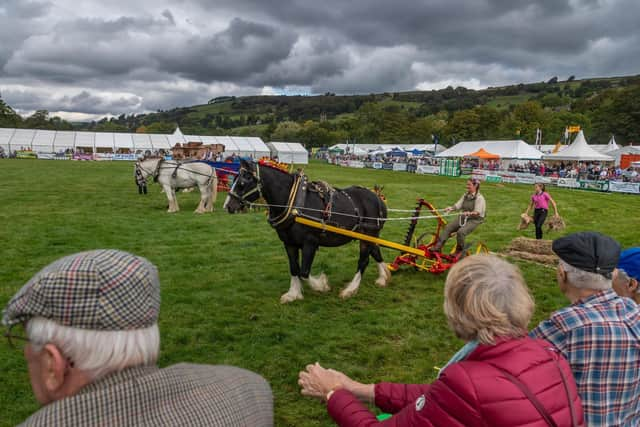Pateley Bridge is a thriving place that combines a stunning rural setting with industrial heritage


This lovely little line – not even 12 miles in length – ran from Harrogate to Pateley Bridge, where there was another service, a light railway, to Angram Reservoir.
Passengers could get on at Harrogate and pass through stations at (among other locations) Hampsthwaite, Darley and Dacre. It was a single-track affair, and ran along the valley of the River Nidd, and surviving pictures reveal that it was spectacularly beautiful.
Advertisement
Hide AdAdvertisement
Hide AdHowever, if you were in a bit of a hurry, it might have been quicker to make your journey on bike, for there were no “passing places” at all. You either went up the line, or you came down it, one train, one direction – and, at its height, you had the option of a full seven services a day to choose from.


What a heritage railway this could have made, a tourist experience to rival the nearby Keighley & Worth Valley, or even the North Yorkshire Moors Railway. Unfortunately it was not to be, for the last passengers rode the tracks on March 31, 1951, and the last heavy goods and freight service pulled out 13 years later.
Those who love the mellowed streets of Pateley Bridge, and the town’s incredible flower displays – which have won major accolades in many Britain in Bloom competitions over the years – might be thinking heavy goods, really? But, in fact, this area of the county sent many tons of stone and lead all over the UK from the time of the Romans.
Nidderdale lead was used on the huge roof of Windsor Castle in 1363, and in the nearby St George’s Chapel you can still find Nidderdale marble, a form of crinoidal limestone which the monks at Fountains Abbey also favoured.
Advertisement
Hide AdAdvertisement
Hide AdWhen you stand on the platforms at Victoria Station in London, or in the National Gallery and other museums in the capital, you are standing on ScotGate Ash stone, a fine example of ancient Millstone Grit, mined in Pateley Bridge. In fact, in 1880, ScotGate Ash quarry was reckoned to be the biggest of its kind operating in the West Riding.


Among the great movers and shakers of the area in the Victorian era was George Metcalfe. He and his family owned mills and breweries, and they were majority stakeholders in Scot Ash. George was the man who pushed for the North-Eastern Railway to build its branch line, and he made sure that the Nidderdale Light Railway connected with Pateley Bridge main station. He was a visionary, and he also employed a large proportion of the local workforce.
Across the centuries, there was also weaving, both in larger mills and in domestic properties. In fact, for several generations, Pateley Bridge was a highly industrialised, albeit rural, hub. And it wasn’t until the 1960s, with the closure of the flax and linen mills, that local industry stuttered.
Happily, the turn-around began almost immediately, with visitors beating a track to the town. It became increasingly popular as a sight-seeing destination, popular with walkers and cyclists, as well as cavers and potholers.
Advertisement
Hide AdAdvertisement
Hide AdThe ground beneath Pateley Bridge is riddled with subterranean caverns, tunnels and waterways, many of them not fully explored, and they act as a powerful magnet for those who like to do their adventures by lamp, rather than by sunlight. Neolithic artefacts – as well as the remains of the animals that our ancestors enjoyed as their evening meal – have all been discovered. Brimham Rocks and Stump Cross Caverns are nearby, and the Six Dales Trail and the Nidderdale Way both wend their path through the centre of town.
If you fancy something a little more leisurely, you can always stop off at the Oldest Sweet Shop in England (opened in 1847), to munch your way through some of its toothsome stock. That claim to be the oldest, by the way, has been authenticated by the Guinness Book of Records.
Pateley itself was first recorded as a community in 1175, but the little village of Wilsill, just two miles away, gets the accolade of a mention in the Domesday Book, where it appears as Wilfeshale, “Wilfel’s patch of land”. It and the 18 villagers all “belonged” to the then Archbishop of York.
Emphasis shifted to Pateley where there was a significant intersection of paths and tracks which went in all directions – to Craven, Ripon and Harrogate.
Advertisement
Hide AdAdvertisement
Hide AdThere was also a good bridge over the Nidd. The right to hold a weekly market was granted by the aforementioned archbishop in 1320, and its successor – on a far grander scale – is the annual Nidderdale Show (the last in the Dales calendar), a celebration of agricultural traditions which regularly attracts around 15,000 visitors. It’s easy to see why, for among the many attractions there is world-beating livestock, dog and horse sections, games of bowls, brass bands, show-jumping, craft exhibitions, vintage tractors, floral displays and a funfair.
There is, to use that well-worn phrase, something for everyone. Despite the pandemic, planning for this year’s show has already begun in earnest, with a date pencilled in for September.
There’s a lot of free-spirited enterprise in Pateley Bridge. The town had its own workhouse – those feared institutions were not the sole prerogative of the densely populated conurbations of Victorian Britain. In 1975 it was an empty shell, but then a group of volunteers formed a committee and decided to create the Nidderdale Museum, a homage to the far bigger Castle Museum in York.
Its exhibits inform visitors about life in the countryside, and include 11 rooms which have been recreated as examples of a general store, domestic parlour, cobbler’s shop and hairdressers from the 1930s, among other bygone displays.
Advertisement
Hide AdAdvertisement
Hide AdIt is a fascinating glimpse into times gone by, and it reveals that many of our ancestors were living in what was far from a rural idyll. The museum succeeded so well that only a couple of years back it was given a prestigious Queen’s Award. Kudos indeed.
There are many competitive cricket teams in Pateley and its hinterland and plenty of thriving independent businesses. If you’re after hand-crafted gifts or artworks you’ll be spoiled for
choice with the number of small galleries and studios. Local artist Claire Baxter, just off a courtyard on the High Street, is among those that have set up shop. “It’s such a supportive, caring community and a lovely place to live and work,” she says.
On a clement day there are few better places to watch the world go by than on one of the many benches in the town. And – a little tip here – if you don’t turn up by car or on your bike, there’s a regular bus service from Harrogate to Pateley Bridge that takes just under an hour to get from one to the other.
It goes cheerfully through some of Yorkshire’s most breathtaking countryside. And if that isn’t a final incentive to pop over to Pateley Bridge, then I don’t know what is.
Comment Guidelines
National World encourages reader discussion on our stories. User feedback, insights and back-and-forth exchanges add a rich layer of context to reporting. Please review our Community Guidelines before commenting.